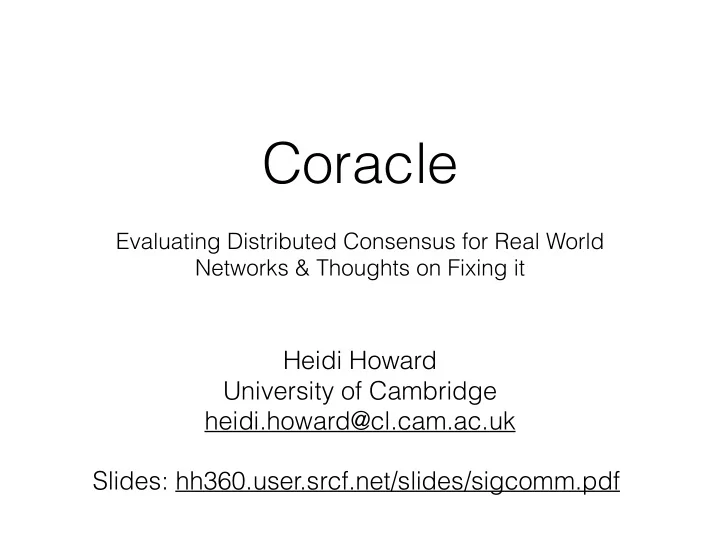

Coracle Evaluating Distributed Consensus for Real World Networks & Thoughts on Fixing it Heidi Howard University of Cambridge heidi.howard@cl.cam.ac.uk Slides: hh360.user.srcf.net/slides/sigcomm.pdf
TL;DR We want to achieve distributed consensus beyond the typical datacenter. Existing algorithms not sufficient to achieve this, due (in part) to limited availability. We can do better. Coracle Unanimous Hydra
Distributed Consensus Applications*: • database transactions • fault tolerant key-value stores • distributed lock managers • terminating reliable broadcast *not forgetting Greek parliamentary proceedings and generals invading a city
Meet Alice Alice
Consensus + Replication = Fault-tolerant app Gaios [Bolosky NSDI’11] = Paxos + RSM Zookeeper [Hunt ATC’10] = Zab + PBR Raft [Ongaro ATC’14] = Raft core + RSM
ASIDE: Raft Explained • Leadership election • Modes of operation • Terms • State machine replication (SMR)
ASIDE: Raft Explained • modes fig
ASIDE: Raft Explained
ASIDE: Raft Explained
Returning to Alice Alice deploys Raft consensus Raft is proven correct Alice Thus, Alice can sleep well
Specified Assumptions • Network communication is unreliable. • Nodes have persistent storage that cannot be corrupted and any write will be completed before crashing. • Asynchronous environment with faulty clocks, no bound for message delay and nodes may operate at arbitrary speeds. • No Byzantine failures.
``They [Raft and other protocols] are fully functional (available) as long as any majority of the servers are operational and can communicate with each other and with clients. Thus, a typical cluster of five servers can tolerate the failure of any two servers.``
DEMO TIME join in at consensus-oracle.github.io/coracle/ and click “Take me to the DEMO"
Meet Bob Use case: Google cloud permutable VMs Problems: node failures are Bob common, machine migration
Meet Charlie Use case: Geo-replicated datacentres Problems: heterogeneous latency, high latency links, Charlie node clustering
Meet Eve Use case: Internet edge Problems: many… Eve
E C B A
New context • Node failures are commonplace • Network latency is unstructured and heterogeneous • Partition are regular, possibly permanent • Reachability between nodes may be asymmetric and non-transitive C B E A
DEMO TIME join in at consensus-oracle.github.io/coracle/ and click “Take me to the DEMO"
Backup: Example 1
Backup: Example 2
Backup: Example 3
Coracle Event based simulation of consensus algorithms on interesting networks with: • pure protocol implementations with Unix & MirageOS support • test suite of interesting and realistic examples
Next Steps • Coracle: Supporting more consensus protocols and studying real networks • Unanimous : New consensus algorithm for real world networks, focused on availability. • Hydra : Self-scaling, self-healing services using Jitsu [Madhavapeddy NSDI ’15] and MirageOS [Madhavapeddy ASPLOS '13]
Fin. Coracle demo: consensus-oracle.github.io/coracle/ Coracle source*: github.com/consensus-oracle/coracle Slides**: hh360.user.srcf.net/slides/sigcomm.pdf C B E A *Code is open source under the MIT license. **Material are released under CC Attribution 4.0 International license.
Recommend
More recommend